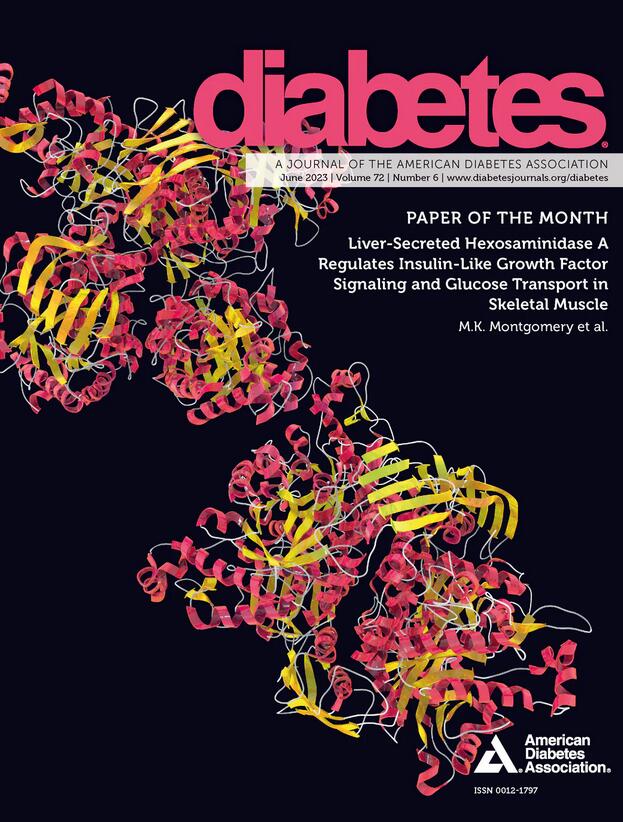350-OR: 在胰腺分化过程中,分娩事件调节内分泌的产生
IF 7.5
1区 医学
Q1 ENDOCRINOLOGY & METABOLISM
引用次数: 0
摘要
破译每个内分泌细胞的发育特征至关重要,这就需要探索生成代用β细胞的有效方法。我们先前开发了三种报告小鼠品系,以量化内分泌祖细胞、β细胞和α细胞的生成。流式细胞术分析表明,出生后新生成的内分泌祖细胞和β细胞数量明显减少。根据这些发现,我们推测分娩过程中的环境变化可能会影响内分泌的生成。我们在以下阶段用报告基因小鼠品系对新生成的内分泌细胞数量进行了定量分析:(i) 胚胎第 19.5 天(E19.5)的胚胎,黄体酮或 COX-1 抑制剂 SC-560 延长了它们的产程;(ii) 胚胎第 19.5 天(E19.5)的胚胎,黄体酮或 COX-1 抑制剂 SC-560 延长了它们的产程。(ii)使用抗孕酮药物 RU-486 的早产幼崽(均在同房后 18.5 天)与 E18.5 胚胎对比。使用 Neurog3-Timer 胰腺流式细胞术显示,(i) E19.5 胚胎中绿色荧光祖细胞的百分比显著高于 P0.5 幼崽(0.80% 对 0.22%,p<0.001),(ii) 早产幼崽中绿色荧光祖细胞的百分比显著低于 E18.5 胚胎(0.66% 对 0.93%,p=0.0018)。同样,用 Ins1-Timer 胰腺流式细胞术检测,E19.5 胚胎的 β 细胞发生率明显高于 P0.5 胚胎(0.36% 对 0.16%,p<0.001)。令人惊讶的是,流式细胞术检测 Gcg-Timer 小鼠的结果是:(i) E19.5 期的α细胞发生率显著低于 P0.5 期(2.1% vs. 2.4%,p=0.035);(ii) 同房后 18.5 天的早产幼崽显著高于 E18.5 期胚胎(0.77% vs. 0.58%,p=0.022),这与 Neurog3-Timer 和 Ins1-Timer 胰腺的研究结果相反。因此,分娩事件抑制了内分泌祖细胞和β细胞的生成,但没有抑制α细胞的生成,这可能反映了分娩过程中α细胞系的不同分子机制。披露 A. Suzuki:无。T. Taguchi:Taguchi: None.S. Ito: 无:无。H. Shimotatara:H. Shimotatara: None.K. Kimura: None.N. Shimizu:无。R. Fujishima:无。M. Himuro:M. Himuro: None.T. Miyatsuka:无。本文章由计算机程序翻译,如有差异,请以英文原文为准。
350-OR: Parturition Event Regulates Endocrine Genesis during Pancreas Differentiation
It is essential to decipher developmental features of each endocrine cell, which leads to exploring efficient methods for generating surrogate β cells. We previously developed three reporter mouse lines to quantify the genesis of endocrine progenitor cells, β cells, and α cells. Flow cytometry analysis revealed a significant decrease in the number of newly-generated endocrine progenitors and β cells after birth. Based on these findings, we hypothesized that environmental changes during parturition could affect endocrine genesis. The number of newly-generated endocrine cells was quantified with the reporter mouse lines at the following stages: (i) embryonic day 19.5 (E19.5) embryos, whose parturitions were prolonged by progesterone or COX-1 inhibitor SC-560 vs. newborn pups at postnatal day 0.5 (P0.5) (both were dissected at 19.5 days after coitus), and (ii) premature pups treated with anti-progesterone drug RU-486 (both were at 18.5 days after coitus) vs. E18.5 embryos. Flow cytometry with Neurog3-Timer pancreata demonstrated that the percentage of green-fluorescent progenitors was (i) significantly higher in E19.5 embryos than in P0.5 pups (0.80% vs. 0.22%, p<0.001), and (ii) significantly lower in premature pups than in E18.5 embryos (0.66% vs. 0.93%, p=0.0018). Likewise, flow cytometry with Ins1-Timer pancreata resulted in a significant increase in β-cell genesis at E19.5 than at P0.5 (0.36% vs. 0.16%, p<0.001). Surprisingly, flow cytometry with Gcg-Timer mice resulted in (i) a significant decrease in α-cell genesis at E19.5 than at P0.5 (2.1% vs. 2.4%, p=0.035), and (ii) a significant increase in premature pups 18.5 days after coitus than in E18.5 embryos (0.77% vs. 0.58%, p=0.022), which is in contrast with the findings in Neurog3-Timer and Ins1-Timer pancreata. Thus, parturition events suppress the generation of endocrine progenitors and β cells, but not α-cell genesis, which may reflect distinct molecular mechanisms in α-cell lineage during parturition. Disclosure A. Suzuki: None. T. Taguchi: None. S. Ito: None. H. Shimotatara: None. K. Kimura: None. N. Shimizu: None. R. Fujishima: None. M. Himuro: None. T. Miyatsuka: None.
求助全文
通过发布文献求助,成功后即可免费获取论文全文。
去求助
来源期刊

Diabetes
医学-内分泌学与代谢
CiteScore
12.50
自引率
2.60%
发文量
1968
审稿时长
1 months
期刊介绍:
Diabetes is a scientific journal that publishes original research exploring the physiological and pathophysiological aspects of diabetes mellitus. We encourage submissions of manuscripts pertaining to laboratory, animal, or human research, covering a wide range of topics. Our primary focus is on investigative reports investigating various aspects such as the development and progression of diabetes, along with its associated complications. We also welcome studies delving into normal and pathological pancreatic islet function and intermediary metabolism, as well as exploring the mechanisms of drug and hormone action from a pharmacological perspective. Additionally, we encourage submissions that delve into the biochemical and molecular aspects of both normal and abnormal biological processes.
However, it is important to note that we do not publish studies relating to diabetes education or the application of accepted therapeutic and diagnostic approaches to patients with diabetes mellitus. Our aim is to provide a platform for research that contributes to advancing our understanding of the underlying mechanisms and processes of diabetes.
 求助内容:
求助内容: 应助结果提醒方式:
应助结果提醒方式:


